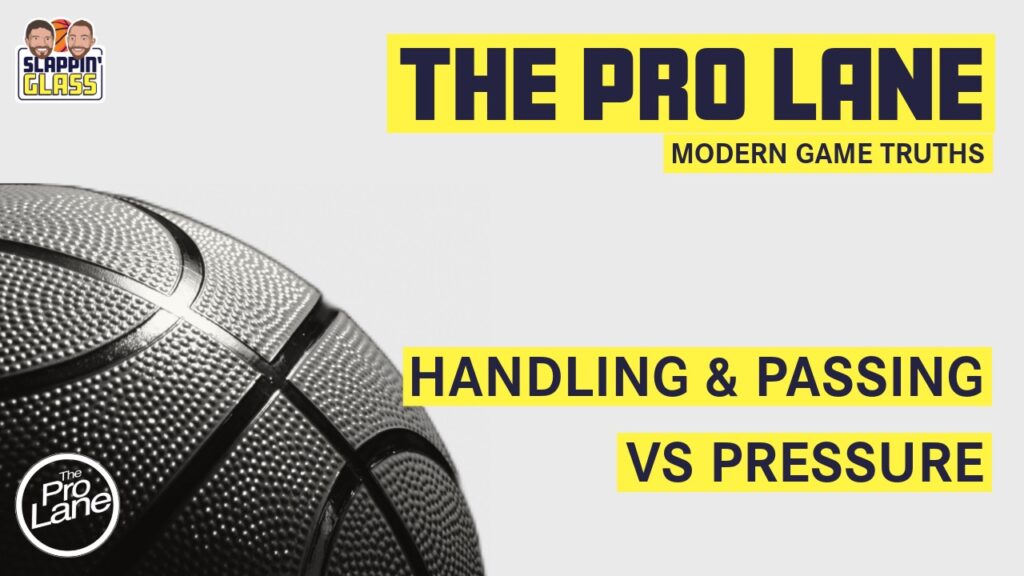It’s sounds simple enough on the surface, but one of the most vital components for the health and functionality of any offense, is dribbling and passing, particularly under pressure. As we discussed this week on the podcast with NAIA Coach of the Year, Scott Moore, the effectiveness and efficiency of Grace College’s Post Offense relies heavily on the ability of his players to make timely and targeted entries into the post.
This concept obviously extends to all areas of the game, as developing a player’s ability to pass the ball on-time and on-target against varied pressure is critical to maintaining offensive flow and timing. The same can be said for dribbling as well. Do players have the ability to locate and attack open space?, can the ballhandler hold space or a spot to allow the offensive possession/action to develop?
Intuitively, we all understand the value and necessity for our players to be able to dribble and pass under pressure. The challenge though, can be in how we develop these skills in a manner that simulates the pressure and unpredictability of a game-like environment.
Today, in our latest “Modern Game Truths” installment with our friends at The Pro Lane, we look into useful ways coaches can layer in elements of dribbling and passing versus pressure in ways that are competitive, fun, and avoid just “checking a box.” In a sense, getting players to “eat their vegetables” without them knowing. But before we dive in, a quick reminder about the project…
Modern Game Truths Series – About the Project
A quick recap, in our collaborative “Modern Game Truths” series with Drew Dunlop and Jake Grossman of The Pro Lane, the objective is to stimulate thought and foster ideas on practical training methods that bridge the gap between the controlled training environment and the dynamic game environment, highlighting the skills, movements, and decisions that occur most frequently in a game and help stitch skills and systems together.
This series explores ways to prepare athletes for the unpredictable and chaotic nature of basketball, creating environments that reflect the challenges presented in the game itself.
Today is the sixth installment in this series, if you need to get caught up, the other five videos include:
- Dynamic Decision Based Warm Ups 🔒
- Opportunistic Movement – Off Ball Shooting 🔒
- Opportunistic Movement – Off Ball Cutting 🔒
- Shooting Under Pressure 🔒
- Finishing Under Pressure 🔒
Let’s dive into today’s Handles & Passing work…
Pressure Starts
By tasking players to first solve a live pressure start in order to trigger a shooting or finishing solution, we found effectiveness in creating a competitive environment that successful mimics the dribbling and/or passing demands of a game while also being able to stack multiple skills into a drill.
For example, below, we see the ballhandler is tasked with first beating a live 1v1 defender across the 3-point line before having to turn, find their footwork, and knock down a shot against another live contest from a second defender.
In this above example, not only is the offense getting a game-like rep against a pressure defender in a tight space, they are then challenged to quickly organize themselves to shoot in a tight space against a closeout.
*Note – These drills are made competitive with different types of scoring systems and constraints for the offense/defense, all of which are detailed in today’s video.
For coaches wanting to change the type of shot the offense is shooting, referencing the example above, the ballhandler could easily outlet a pass to the coach after beating the defender to the three-point line, and then play from a “catch and shoot” situation rather than a live dribble. Here’s how that concept looks in another drill example here…
Zooming In: In the drill “1v1 Pressure Box – Pass & Chase,” the ballhandler is constrained to a 3×3 ft box and challenged to hold their space with the dribble before delivering an on-time, on-target pass when triggered by the post player (raising their hands). This is a great example too of working with players to hold a spot on the floor in order to facilitate the offense, rather than breaking the offense to attack on the first sign of pressure.
Validations
A great way to add pressure to any drill or practice environment is through the use of validations, meaning some type of action must happen in order to “win” the drill. One of the more common validation is having to make a Free Throw after a score, but validations can come in many forms like executing an ATO, BLOB, or SLOB after a score to secure the point or, as demonstrated in today’s episode, getting a defensive stop after a score…
Zooming In: In the drill “1v1 Angle Change,” after scoring, the offensive player immediately transitions to defense and must turn the ballhandler twice in the backcourt to secure their points. Through the course of the drill, as the stakes are raised, the players really compete to either turn the ballhandler or beat the pressure with the dribble.
Today’s series shows many more examples, along with voice-over explanations, of different ways to incorporate pressure starts into passing and ballhandling drills with the aim of creating players who are able to play and organize offense through the variability that the pressure of the game throws at them.
Please enjoy this week’s newest installment of the “Modern Game Truths” Series with the Pro Lane on SGTV…
